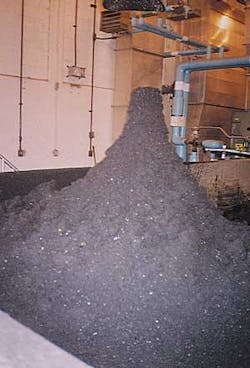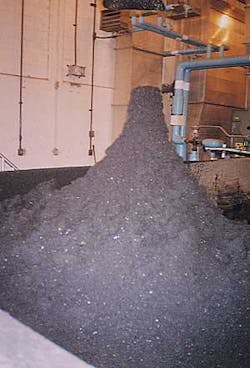Fine Grit Removal Helps Optimize Membrane Plants
By Robert Y.G. Andoh and Adam Neumayer
Membrane technology is an innovative, compact solution to the age-old wastewater treatment problems of effluent quality and footprint. Membranes, which combine clarification, aeration and filtration into a single process, are noted for their ability to consistently deliver a high quality effluent in a cost-effective manner in the confines of a small footprint. Although membrane bioreactors (MBRs) offer many advantages, the membranes are sensitive to abrasive materials, such as fine grit which can erode the equipment to the point where it no longer functions.
Small grit particles are a major culprit of maintenance problems at membrane plants. Grit that flows past the membrane header becomes embedded in the membrane’s hollow fibers, requiring frequent cleanings that can damage the sensitive fibers.
Also, MBRs allow higher mixed liquor suspended solids (MLSS) concentrations and a longer solids residence time (SRT) compared to conventional treatment process. Once the fine grit gets past the headworks, it tends to accumulate in the aeration basin causing an elevation in solids concentration and exacerbating the associated maintenance and operational problems. This elevation in solids concentration directly increases the volume of solids in the membrane’s discharge.
Pre-treating wastewater with fine screening technologies has evolved into a well accepted best practice in membrane plant design. However, additional pretreatment measures are required to provide membrane plants with a higher level of protection from fine grit.
Grit-removal systems come in a wide array of grades and functions and, like membranes, have evolved considerably over the past 20 years. Traditional systems such as horizontal-flow, aerated grit basins and vortex paddle wheel-type mechanisms have typically been sized to remove grit particles down to 200 - 300 microns in diameter size range. These systems can work well in some localities where the impact to downstream equipment of fine grit “carry-over” (by-passing) is minimal. However, membrane plants need more effective grit removal devices – those sized to remove particles down to 75 – 106 microns - to truly protect the communities’ investment.
Fine Grit Removal
Advanced vortex separation technology is rapidly becoming the industry’s “best practice” pretreatment technology because it offers higher performance in a smaller footprint with less lifetime maintenance as compared with conventional grit removal technology.
There are a variety of vortex grit removal devices available to specifically target and remove grit from wastewater streams. These can be classified as either “mechanical vortex” or “induced vortex” separators. Induced vortex separators use tangential intakes to create a vortex flow path that augments gravitational settling with centrifugal or inertial forces and boundary layer effects to separate solids from liquid. Induced vortex separators are preferable to mechanical alternatives since induced vortex separators require no power source to function properly, reducing the comparative operational and maintenance costs over the life of the system.
There are other important considerations that need to be taken into account in the selection and design of an appropriate vortex grit separation system. These include factors such as pressure drop or “headloss”, ability to handle shock loadings and wide turn-down ratios, ease of retrofit into existing chambers, the complete system makeup and efficacy of individual process stages.
There are numerous keys to grit system design that optimize removal efficiency and serve to prevent fine grit from wreaking havoc on a membrane plant.
- Understand the level of grit removal needed and design accordingly. The level of protection from grit will depend on the unit processes that a wastewater plant has downstream. More sensitive process equipment will require greater levels of protection from grit. The level of grit removal needed to offer adequate protection will depend on the characteristic of grit in the plant’s wastewater influent. Coarser and denser grit is easier to separate than finer, lighter grit, which requires more advanced grit removal processes.
- Understanding of what needs to be removed is key. Pretreatment requirements for MBRs are similar to and in some instances can be more onerous than other established technologies such as fine bubble aeration and centrifuges where fine grit removal is becoming common practice.
- Maximize the surface area for settling. Increasing the surface area for settling lowers the effective hydraulic loading rate, thereby increasing grit removal efficiency.
- Maximize the utilized volume of the grit removal chamber. Typically with settling chambers, the larger the volume of the chamber, the better the resulting grit removal performance. However, some tanks, such as those prone to thermal stratification and hydraulic short-circuiting, do not use the full chamber volume. By structuring the flow through the unit properly, the facility can maximize the volume of the flow that the chamber can efficiently treat. Advanced vortex systems, for example, minimize short-circuiting using specially design internal flow modifying components. Tray systems accomplish this by distributing flow evenly across multiple surfaces. This allows for the use of a larger overall surface area available for settling in a smaller footprint.
- Minimize the settling distances. Shortening the distance that grit must travel to settle out of suspension in the flow stream reduces the required residence time that the flow must spend in the grit removal chamber. One of the most effective ways to shorten settling distances is by stacking settling trays vertically within a cylindrical grit removal chamber and distributing the flow of wastewater evenly across the trays.
- Understand and use boundary layer clarification. As flow moves over a solid object, it creates a velocity profile that slows down the flow closer to the wall where the object and liquid make contact. Solids can settle out of liquid more readily in this lower velocity zone. Optimizing a grit chamber design to exploit this “boundary layer effect” is an efficient way to separate out grit from organic solids and water.
- Leverage the advantages of complete system design. The performance of each unit process in a grit removal system is critical to prevent grit from bypassing into the downstream process. If one stage in the process fails to capture the grit sent to it, the whole system fails. So as the old axiom goes, the grit system is only as strong as its weakest link.
Conclusion
As membranes have evolved over the past decade, the industry’s knowledge of best practices to maximize their lifecycle has expanded rapidly. Although fine screening techniques have been a standard pretreatment technique for membrane plants, today, we beginning to realize that we also need more effective fine grit removal upstream of MBRs. Small grit particles degrade the membrane fibers, causing performance failures and maintenance problems. Optimizing upstream grit removal protects the wastewater treatment facility and helps operators realize the full treatment and economic benefits of their investments in MBRs.
About the Authors:
Dr. Robert Y.G. Andoh is Director of Innovation at Hydro International, of Portland, ME, a provider of products and systems that control and treat stormwater, wastewater and combined sewer overflows. Adam Neumayer is the Sales Applications Manager at Hydro International’s US Wastewater business based in Hillsboro, OR. They can be reached by email at [email protected].


